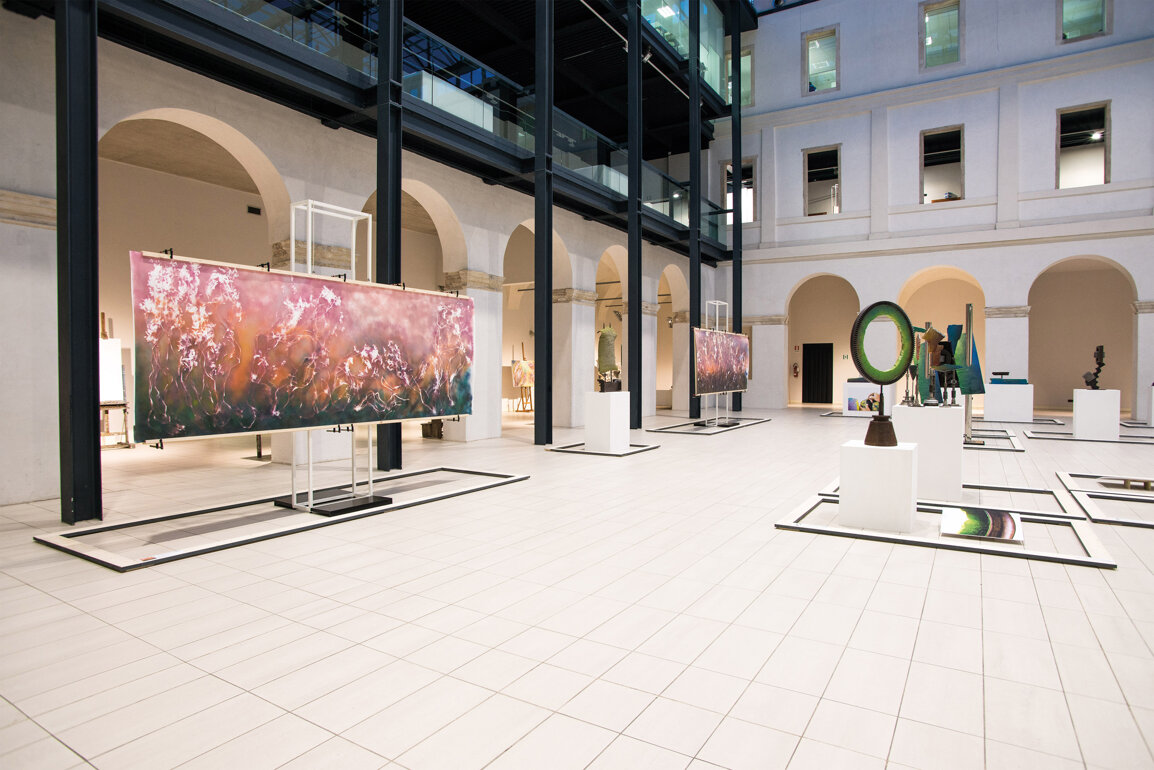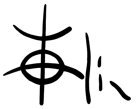® Copyright 2025 | ART RAMPIN FRANCESCO | Tutti i diritti riservati.


LA PELLE DEL PORFIDO
FRANCESCO RAMPIN
EDITORIALE GIORGIO MONDADORI
DETTAGLI
Autore | FRANCESCO RAMPIN
Curatore | ARCH. MATTEO RAMPIN
Editore | EDITORIALE GIORGIO MONDADORI
Anno edizione | 2022
In commercio dal 19 Novembre 2022
Pagine | 244 p., ill. , Rilegato
ISBN | 9788837419707

FRANCESCO RAMPIN | L'EMPATIA DELLE COSE : LA PELLE DELL'ARTE.
Quello che c’è di più profondo nell’essere umano è la pelle.
(Paul Valéry)
L'arte è una serie ciclica e mai paga di sensazioni, un insieme di emozioni che possono sgorgare direttamente dalle opere e dai lavori proposti da un artista, visioni di sogni che prendono lentamente forma e si espongono alla vista dello spettatore che in esse si perde, si riconosce o semplicemente le trova conformi al suo sentire.
Spesso si dice che l'affinità è solo una questione "di pelle", uno scambio simbiotico emozionale che mette in contatto l'uomo con ciò che più trova somigliante e attinente con le sue percezioni.
La pelle, la pelle che cambia, muta e si rigenera è l'elemento di confine con l'esterno e che prima di tutti gli altri sensi mette in contatto l'uomo con la vita, con lo spazio circostante fin dalla nascita perché, prima di vedere e udire, l'essere umano percepisce, attraverso il tatto, ciò che lo circonda.
L'artista quando crea ha un contatto fisico con i suoi lavori: uno studio è pregno di odori di vernici, di colori, di solventi, di strumenti, di legno, di ferro e di sogni, è un insieme di strane cose che diventano poi elementi e sensuali visioni nelle quali ritrovarsi e perdersi.
Un artista abbisogna della fisicità, necessita che la sua pelle sia in relazione con la pelle dei materiali, stabilisce in tal modo un contatto con la forma che è plasmata e forgiata da chi fatica ad estrapolarla, anche se fosse recuperata da un semplice pezzo di legno riciclato, da un ferro arrugginito e abbandonato, è una creatività e fantasia che riesce a vedere oltre la struttura, oltre la pelle, l'artista compenetra quello che è solo visione o solo tatto, sa guardare, non solo vedere.
Perché una scultura, una pittura, un ensemble di materie si associ e diventino poi opere d'arte è fondamentale entrare nell'anima delle cose e, soprattutto, nell'interiorità di chi le sagoma: la pelle dell'artista diventa tutt'uno con la pelle della materia e poco importa che il freddo, il calore, la ruvidezza, la levigatezza provengano da una delle sole parti, è in realtà uno scambio continuo, è una carezza costante tra uomo e materia.
Con Francesco Rampin non si parla di scultura o di pittura, lo stesso artista non si può definire semplicemente scultore o pittore, l'arte nel modo classico così come è recepita nel mondo contemporaneo non ha una formulazione, non può essere etichettata, spesso la sua pittura si fa materia e la scultura si fa leggera, con una gamma coloristica tratta direttamente da una tavolozza di colori che si perde tra il surreale e il metafisico, il modus operandi del pittore e dello scultore si smarrisce e fonde in un unicum e si parla di cose create, di Arte.
La capacità di Francesco Rampin è legata alla forma e al colore che si dotano di significati, di simbologie iconiche già presenti nei titoli delle sue composizioni che recuperano miti antichi, letture, religioni, riti sciamanici e rinascono sotto formule sacrali e preziose diventando ostensori, vele e navi, tocchi di magia, legami tra sacro e profano dove è l'uomo causa ed effetto in un mondo fatto di ricordi, storia e visioni di un futuro che pulsa di vita da vedere e da toccare.
I rimandi storici alla materia nel corso del Novecento son ben ponderati da Francesco Rampin e il ricordo si propaga con l'accostamento degli objet trouvé e i ready-made di Marcel Duchamp, le opere di Picasso fatte con la percezione della gioia del fare, con le linee di Costantin Brancusi e, in una sorta di conciliazione col passato, con la lavorazione proposta nelle opere dell'Arte Povera, del Nouveau Réalisme e di tutti quegli artisti che hanno fatto dell’objet trouvé un objet artistique. [1]
Francesco Rampin, come altri artisti contemporanei, trasforma a volte, attraverso un processo di recupero, gli oggetti rifiutati dalla società per ricollocarli e variali in opere d'arte: dallo scarto alla rinascita attraverso una rigenerazione empatica, un contatto, appunto, a pelle.[2]
Diceva Costantin Brancusi, cui per alcuni aspetti fatti per compostezza e levigatezza Francesco Rampin sembra trarre insegnamento: "La semplicità non è un fine dell’arte ma si arriva alla semplicità malgrado se stessi avvicinandosi al senso reale delle cose. La semplicità è la complessità stessa – ti devi nutrire della sua essenza per comprenderne il valore".[3]
Le cose che si creano sono enigmatiche e misteriose, vibrano con i tocchi di colore sapientemente condotti dalla mano dell'artista e le prove pittoriche assumono variegati aspetti: delicate forme fluttuanti in un magma di pigmenti intervallate da guizzi di luce, squarciate carcasse di pastosa formale materia riconducibili a opere di Rembrandt, tenui figure quasi acquerellate e sfumate che si contrappongono alla pesantezza del ferro, del porfido, del legno di un maestoso ciliegio che ancora vive a guisa di totem.
Si palesano inoltre collegamenti verso il cielo che partono dalla terra, simboliche torri di babele che nascondono altri linguaggi, altre visioni, questi monoliti uniscono il mondo terreno con quello della spiritualità in ricercata armonia di equilibri dove lo sguardo rimane a contatto con l'anima e la voglia di toccare l'opera rimane perché si cerca il divenire in una parte di essa.
Se Francesco Rampin come pittore "vede", come scultore invece "sente" i colori e la materia poiché con le sue composizioni rende la forma con i materiali arrivando a sperimentare l'incidenza della luce e palesando nella tridimensionalità azzardi cromatici nella superficie.
La scultura contemporanea dell'artista completa così uno spazio bidimensionale stravolgendo stili e mescolanze e conducendo un nuovo modo di comporre abolendo i confini delle arti, togliendo la percezione univoca, il risultato è quello di rimanere senza pelle, senza contatto, senza protezione per una libertà delle emozioni, consapevolezza dello strato vivo che anima e colpisce un mondo fatto di strane cose, fatto e vissuto d'arte.
Padova 07.12.2017
FRANCESCO RAMPIN | THE EMPATHY OF THE OBJETCS: THE ART'S SKIN.
What is deeper in a man is the skin
(Paul Valéry)
Art is a cyclic series, never fully satisfied with sensations, a mixture of emotions which might surge directly from the works made by an artist, visions of dreams that gradually take shape and are shown to the viewers who either get lost in them or identify with them, or more simply find them connected to his way of feeling.
We often claim affinity has to do with « skin », an emotional, symbiotic exchange which keeps man in touch with what is most similar to his own perceptions.
The skin which changes and regenerates is a border-line element which first among all senses keeps man in contact with life, with the surrounding space since birth because the human being first perceives through touch what is around him, even before seeing and hearing.
When the artist creates he has a physical contact with his works: a studio is full of varnish smells, colours, tools, wood, iron and dreams, it’s a mixture of strange things that become elements and sensual visions in which to get lost and meet again.
An artist needs bodily presence, needs his skin to be in touch with the raw materials’ skin, he establishes a contact with shape which is moulded by those who struggle to get it out, in spite of it being recovered from a simple piece of recycled wood, a rusty, forgotten piece of iron, since it is only creativity and fantasy which can see beyond the surface, the artist can penetrate what can be perceived only through sight and touch, he can stare and not only see.
So that a sculpture, a painting, a bunch of materials might be transformed into a work of art you need to enter the objects’ soul and above all the inner depth of the one who moulds them.
The artist’s skin becomes one with the raw material’s skin and it doesn’t matter if a cold, hot, rough or smooth surface is what you finally get, since we are dealing with a continuous exchange, a never ending caress between man and substance.
Along with Francesco Rampin we cannot really deal only with sculpture or painting. The artist as well cannot define himself simply as a painter or a sculptor. Art as it is conceived in our contemporary world cannot be fully explained and labelled; often painting becomes substance and a sculpture becomes light through a range of colours coming directly form the painter’s palette.
The painter’s or sculptor’s modus operandi gets lost and becomes something unique, it becomes Art.
Francesco Rampin’s ability is connected to shape and colour which carry other meanings, iconic symbols which are already present in the titles of his works and recover ancient myths, religions, shamanistic rites and are born again through sacred formulas becoming ostensories, sails, ships, magic touches, connections between the sacred and the profane, where man is the principle in a world made up by memories, history and visions of a future which vibrates with life to perceive and touch.
Historical references to « substance » all over the 20th century are well pondered by Francesco Rampin and the memory extends through juxtapositions with objet trouvé and ready-made by Marcel Duchamp, Picasso’s joyful works, Constantin Brancusi lines, and in a kind of reconciliation with the past, with Arte Povera, Nouveau Réalisme and with all those artists that created an objet artistique out of an objet trouvé.
Francesco Rampin, as well as other contemporary artists, sometimes transforms through a salvaged process those objects rejected by society to relocate them and transform them into works of art; from waste to rebirth, through an empathic regeneration, a « skin contact ».
Constantin Brancusi claimed « Simplicity is not an objective in art, but one achieves simplicity despite one’s self by entering into the real sense of things. Simplicity is complexity resolved- you need to feed yourself on its essence to understand its value ». For some aspects Francesco Rampin seem to have learnt from this statement.
Rampin’s creations are enigmatic and mysterious. They vibrate through colour brushes wisely led by the artist’s hand and pictorial proofs appear through various aspects: delicate forms floating in a jumble of pigments, interrupted by glimpses of light, lifted carcasses of material, doughy substance, ascribable to Rembrandt’s works, tenuous figures almost water-coloured and shaded which counterpose to the heaviness of iron, of porphyry, of a gigantic cherry-tree which still lives as a totem.
Links from the ground to the sky reveal themselves, symbolic babel towers that hide other languages, other visions, these monoliths unite the earthly world to the spiritual one looking for an harmony of balances where the sight keeps in contact with the soul and the desire to touch the work of art remains because you are looking for the becoming of a part of it.
Francesco Rampin sees as a painter; as a sculptor he feels the colours and the substance since through his compositions he builds up shapes by experimenting with the incidence of light and revealing on their three-dimensional surface chromatic hazards.
The contemporary sculpture of the artist completes in such a way a two-dimensional space getting rid of styles and mixtures, and leading to a new creative process which abolishes borders between the arts as well as an univocal perception. What comes out of it is the sensation of being deprived of our skin, without any kind of contact or protection, to achieve an emotional freedom, being conscious of the living layer that animates and strikes a world made of strange things, made and lived through art.
Padova 07.12.2017















